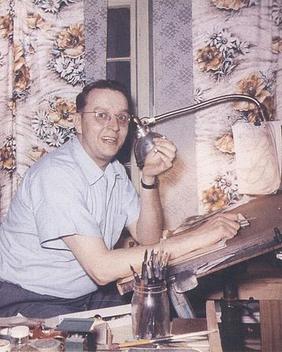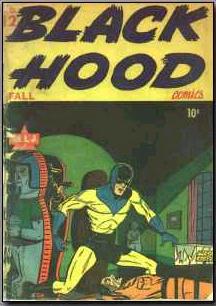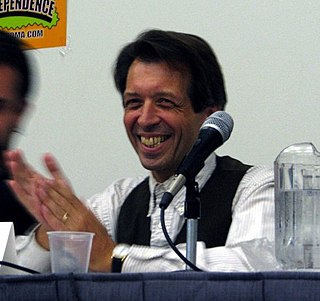
A cartoon is a type of visual art that is typically drawn, frequently animated, in an unrealistic or semi-realistic style. The specific meaning has evolved, but the modern usage usually refers to either: an image or series of images intended for satire, caricature, or humor; or a motion picture that relies on a sequence of illustrations for its animation. Someone who creates cartoons in the first sense is called a cartoonist, and in the second sense they are usually called an animator.

Jack Ralph Cole was an American cartoonist best known for birthing the comedic superhero Plastic Man, and his cartoons for Playboy magazine.

King Features Syndicate, Inc. is an American content distribution and animation studio, consumer product licensing and print syndication company owned by Hearst Communications that distributes about 150 comic strips, newspaper columns, editorial cartoons, puzzles, and games to nearly 5,000 newspapers worldwide. King Features Syndicate also produces intellectual properties, develops new content and franchises, and licenses its classic characters and properties.

Basil Wolverton was an American cartoonist and illustrator known for his intricately detailed grotesques of bizarre or misshapen people. Wolverton was described as "Producer of Preposterous Pictures of Peculiar People who Prowl this Perplexing Planet." His many publishers included Marvel Comics and Mad magazine.

Don "Duck" Edwing was an American gag cartoonist whose work has appeared for years in Mad. His signature "Duck Edwing" was usually accompanied by a small picture of a duck, and duck calls were heard on his answering machine. Mad editor John Ficarra said, "He's exactly how people picture a Mad magazine writer." In 2007, Edwing told an interviewer, "I always believed that when you choose your field, you should specialize. You never deviate. I chose 'sick puppy'."

James Cecil Hatlo, better known as Jimmy Hatlo, was an American cartoonist who in 1929 created the long-running comic strip and gag panel They'll Do It Every Time, which he wrote and drew until his death in 1963. Hatlo's other strip, Little Iodine, was adapted into a feature-length movie in 1946.

Henry Boltinoff was an American cartoonist who worked for both comic strips and comic books. He was a prolific cartoonist and drew many of the humor and filler strips that appeared in National Periodical comics from the 1940s through the 1960s.

Black Hood Comics was the name of an American anthology comic book series published by MLJ Magazines Inc., more commonly known as MLJ Comics, for eleven issues between Winter 1943 and Summer 1946. The series featured MLJs costumed hero Black Hood, and "Boy Buddies", featuring Shield's partner 'Dusty the Boy Detective' and Wizard's side-kick 'Roy the Superboy', together with humor strips.
Super Duck was a comic book character created in 1943 for what was then MLJ Comics by staff artist Al Fagaly. As his name implies, Super Duck was originally a parody of Superman, even down to a red and blue costume. But his time as a superhero was short, and by late 1944 his stories became more conventional, in the Disney/Carl Barks mode.

Batton Lash was an American comics creator who came to prominence as part of the 1990s self-publishing boom. He is best known for the series Wolff and Byrd, Counselors of the Macabre, a comedic series about law partners specializing in cases dealing with archetypes from the horror genre, which ran as a strip in The National Law Journal, and as a stand-alone series of comic books and graphic novels. He received several awards for his work, including an Inkpot Award, an Independent Book Publishers Association's Benjamin Franklin Award, an Eisner Award, and nominations for two Harvey Awards.
Samm Schwartz was an American comic artist best known for his work in MLJ and Archie Comics, specifically on the character Jughead Jones.

Firefly is a superhero created by Harry Shorten and Bob Wood for MLJ Comics in 1940. He first appeared in Top-Notch Comics #8. Artist Warren King and writer Joe Blair loaned their talents to many of the Firefly's installments.
Harry Frank Sahle was an American comic book artist who drew for such publishers as Archie Comics—helping create the defined look of Archie Comics' breakout character, Archie Andrews—Quality Comics and the Marvel Comics precursor company Timely Comics during the 1930s-1940s period historians and fans call the Golden Age of Comic Books.

Jackpot Comics was the name of an American anthology comic book magazine series published by MLJ Magazines Inc., more commonly known as MLJ Comics, for nine issues between Spring 1941 and Spring 1943. It featured new stories of a number of characters previously seen in other MLJ publications.

Top-Notch Comics is an American comic book anthology series that was published by MLJ Magazines Inc., more commonly known as MLJ Comics, during the 1930s and 1940s period known as the Golden Age of Comic Books. From issue #28 it was re-titled Top-Notch Laugh Comics.

Shield–Wizard Comics was the name of an American comic book series published by MLJ Magazines Inc., more commonly known as MLJ Comics, for thirteen issues between Summer 1940 and Winter 1944.

McClure Newspaper Syndicate, the first American newspaper syndicate, introduced many American and British writers to the masses. Launched in 1884 by publisher Samuel S. McClure, it was the first successful company of its kind. It turned the marketing of comic strips, columns, book serials and other editorial matter into a large industry, and a century later, 300 syndicates were distributing 10,000 features with combined sales of $100 million a year.
Harry Shorten (1914–1991) was an American writer, editor, and book publisher best known for the syndicated gag cartoon There Oughta Be a Law!, as well as his work with Archie Comics, and his long association with Archie's publishers Louis Silberkleit and John L. Goldwater. From the late 1950s until his 1982 retirement, Shorten was a book publisher, overseeing such companies as Leisure Books, Midwood Books, Midwood-Tower Publications, Belmont Tower, and Roband Publications.
Donald Duck is an American comic strip by the Walt Disney Company starring Donald Duck, distributed by King Features Syndicate. The first daily Donald Duck strip debuted in American newspapers on February 7, 1938. On December 10, 1939, the strip expanded to a Sunday page as well. Writer Bob Karp and artist Al Taliaferro worked together on the strip for more than 30 years. The strip ended in May 1995.
There Oughta Be a Law!, or TOBAL!, was a single-panel newspaper comic strip, created by Harry Shorten and Al Fagaly, which was syndicated for four decades from 1944 to 1985. The gags illustrated minor absurdities, frustrations, hypocrisies, ironies and misfortunes of everyday life, displayed in a single-panel or two-panel format. There Oughta Be a Law! was similar to Jimmy Hatlo's They'll Do It Every Time. TOBAL! was initially syndicated by the McClure Newspaper Syndicate; eventually it moved over to United Feature Syndicate.














